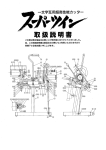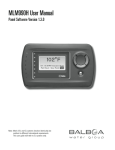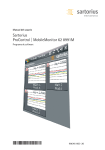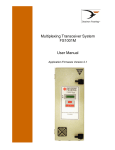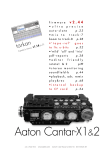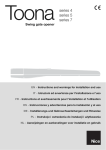Download "user manual"
Transcript
In this Issue May 2006 Volume 7 Issue 2 1 2 The PTAGIS Newsletter is published periodically by Pacific States Marine Fisheries Commission. We welcome input from the PTAGIS community, so email or write us with your story ideas. If you have questions regarding the contents of this publication, or about the PTAGIS program, please contact Carter Stein, PTAGIS Program Manager. Unless otherwise noted, contributors include: 3 4 Development of a PIT-TAG SYSTEM for the Corner Collector at Bonneville Dam Modification to INTERROGATION DATA LOADER RSS Feed for PTAGIS INTERROGATION DATA LOADER Windows MOBILE 5.0 and MOBILEMONITOR CARTER STEIN [email protected] DAVE MARVIN dave [email protected] 5 DIGITAL ANGEL SERVICES to the Fisheries Community 6 Digital Angel Product Alert: FS1001M MUX TRANSCEIVER 7 FS1001M MUX TRANSCEIVER Self-Tests and Diagnostics 8 PTAGIS 10 YEARS AGO 9 REQUEST FOR PIT TAGS — PIT-Tag Evaluation JOHN TENNEY john [email protected] Kristiana Kroneck kristiana [email protected] PTAGIS 205 SE Spokane St. Suite 100 Portland, OR 97202-6413 503.595.3100 503.595.3232 fax A Fisheries Data Project of the Pacific States Marine Fisheries Commission DID YOU KNOW ? Since 1993, PIT-Tagged fish are, by default, diverted back to the river at the Juvenile Fish Transportation Facilities in the Snake and Columbia Rivers. If you require your study fish to be transported from these facilities, or to be collected and held at any facility, then contact PTAGIS to implement a Separation by Code Request. Correction Due to an editing error, an article in the March 2006 PTAGIS Newsletter, “Biomark Instream Installation of PIT-Tag Detector Systems,” appeared without a byline. PTAGIS would like to extend an apology and due credit to the author, Steve Anglea of Biomark, Inc. May 2006 Volume 7 Issue 2 Development of a PIT-tag Detection System for the Corner Collector at Bonneville Dam [ January – April 2006 Update ] Sandra L. Downing (NOAA’s National Marine Fisheries Service) DENNIS SCHWARTZ and HEIDI HELWIG (The Us Army Corps of Engineers) GREAT NEWS — all pieces of the project for developing a PIT-Tag detection system for the corner collector at FIGURE 2 • M edian Read Ranges in 4 ft by ft Antena Bonneville Dam are coming together. We are on track with high hopes that it will be able to meet the 60 percent detection goal. ,i>`ÊÀ>}iÊ® for having a system in place for the 2006 outmigration, Óx Transceiver Digital Angel (DA) has produced four transceivers for the corner-collector system (Figure 1). DA installed one of the transceivers into the new electronics building on 23 March 2006. FIGURE 1 £x £ä x ä Everyone involved needs to be congratulated for all of the hard work that has gone into getting us to this point. To mention some of the key players and their roles: The U.S. Army Corps of Engineers (Corps) was responsible for designing and constructing the concrete flume structure that holds the slot antenna. Bonneville Power Administration (BPA) was responsible for developing the electronics for the project. They contracted Digital Angel to design and fabricate all phases of the PIT-Tag system (transceiver, antenna, and tags). BPA also contracted Pacific States Marine Fisheries Commission (PSMFC) and National Marine Fisheries Service (NMFS) to assist with the project. Below are brief status reports and photos for the main components of the corner collector PIT-ag system. Óä -/ÊÌ>} -ÊÌ>} --/ÊÌ>} Initial testing showed that the SST tag model performed better in a 4 ft by 4 ft test antenna than the SGL tag model. Tags In December 2005, PSMFC and NMFS evaluated samples from DA’s next production tag model (TX1400SST), which they developed for the corner-collector application. DA took the feedback from the fisheries community and improved the first tag model (SGL) they had designed for the corner-collector application to produce a tag model (SST) that has the same physical parameters (i.e., weight, length, width) as the current ST tag model. Initial testing showed that the SST tag model performed better in a 4 ft by 4 ft test antenna than the SGL tag model (Figure 2). In addition, performance results were consistent among the tags, which was not true for the SGL tags. BPA and DA have agreed on a contract for producing the SST tags, and so they will be replacing the SGL and ST tags as the new standard tag. The tags should be available through PSMFC by this summer. In April, we will determine how well the ST and SST tag models read in the 17 ft by 17 ft antenna when we can test the corner-collector system after the Corps contractors are done. Antenna DA contracted with PolyCycle Industrial Products out of Pittsburgh, PA, a world leader in large polypropylene tank Digital Angel produced four transceivers for the corner collector at Bonneville Dam. and enclosure fabrication, to build the antenna housing. This new antenna design was completely different from the first antenna design – it is hollow in the middle, which allows us to keep moisture away from the antenna wires by controlling the environment using a HVAC system. CONTINUED May 2006 Volume 7 Issue 2 Development of a PIT-Tag Detection System for the Corner Collector at Bonneville Dam PolyCycle fabricated the two halves of the antenna housing (made from a copolymer polypropylene thermoplastic material) at its plant, and then assembled the antenna housing onsite at Bonneville Dam in the second powerhouse in February (Figures 3.a & b). Hats off to the Corps for its invaluable assistance. DA and PSMFC wrapped the antenna and then DA did the tests they could do in a powerhouse environment. Based on the test results, the antenna performed similarly to the prototype antenna in Minnesota that was used by DA to develop the antenna. FIGURE 4 Installation The Corps issued a contract to Slayden Construction Group, Inc., from Oregon, for the construction phase of the project. Slayden first dismantled the flume section (Figure 4) and then built the concrete support structure for the antenna housing using non-metallic materials that will not interfere with the PIT-Tag interrogation system (Figures 5). The support structure includes a huge grounding grid and the aluminum shield that must surround the antenna for it to work properly (Figure 6). Slayden Construction Group, Inc. dismantled the flume section. FIGURE 5 FIGURE 3 Slayden Construction Group, Inc. built the concrete support structure for the antenna housing using nonmetallic materials that will not interfere with the PIT-Tag interrogation system. A B PolyCycle Industrial Products assembled the antenna housing onsite at the Bonneville Dam in the second powerhouse in February 2006. On 23 March 2006, Slayden moved the antenna structure from the powerhouse to the flume (Figures 7.a, b & c). The Corps held a final walk-through for the construction phase on 7 April. The complete PIT-Tag detection system was installed on 23 March into its final site, but it then needed to be tested in order to learn how it needed to be adjusted to work at this location. As indicated in the last update, the antenna housing would first be tested under dry flume conditions with test equipment and the transceiver. After being satisfied with the performance under dry conditions, DA plan to then test the system under operational conditions to determine how the PIT-Tag system changed when the flume was watered up. The Corps watered up the flume on 8 April for 4 hours and then DA made some adjustments before a 24-hour test was run on 11 April. DA then conducted the tests with the ST and CONTINUED May 2006 Volume 7 Issue 2 Development of a PIT-Tag Detection System for the Corner Collector at Bonneville Dam FIGURE 6 FIGURE 7 A PolyCycle Industrial Products assembled the support structure, which includes a huge grounding grid and the aluminum shield that must surround the antenna for it to work properly. SST tags on 12 April and the corner collector was back open for fish passage on 13 April. PSMFC is in the final stages of setting up the site to upload the detection data to the PTAGIS database. They should be finished by 21 April. Next steps B One of the unknowns is what the electromagnetic noise levels will be at this site and how they will affect the PITTag equipment. Since these noises are rarely constant, monitoring will need to be done over time for DA to determine how best to adjust its equipment. Starting on 24 April, NMFS will be assisting DA by releasing floating drones that will hold tags at different water depths. In addition, NMFS will also be releasing tagged fish to assist DA in setting up its equipment. As we learn more during the 2006 season, DA is anticipating that they will be making adjustments to its equipment. It may be necessary to return to dry conditions occasionally to make these adjustments. Therefore, a full biological research evaluation will be funded by BPA in 2007 to determine the tag-reading efficiencies for different salmonid populations traversing the flume environment. To help design this evaluation, NMFS will be releasing tagged fish from multiple locations in front of the entrance to the corner collector to determine if this variable affects tag detection by the PIT-Tag system. C On 23 March 2006, Slayden Construction Group, Inc. moved the antenna structure from the powerhouse to the flume. BCC is the site identification code for the newly installed Bonneville Corner-Collector System. May 2006 Volume 7 Issue 2 Modification to Interrogation Data Loader (IDL) DOUG CLOUGH (Synergetics Engineered Systems) Two modifications have been made in the pre-processing of interrogation records by the Interrogation Data Loader FIGURE 1 • Storing Tranceiver ID in cksm column (IDL). These changes are not retroactive, and therefore only ÕÌ«iÝi` /À>ÃViÛiÀ apply to data received on or after 27 February 2006. 1. Store transceiver identifiers For data arriving in Minimon, MobileMon, or M4 files, store the transceiver identifier in the cksm column of the obs_data database table (Figure 1). Note that this value is available only if the interrogation was captured by a multiplexing transceiver, for example a Digital Angel FS1001M. If the interrogation was captured by a non-multiplexing transceiver, such as a Digital Angel FS1001A, store the coil identifier (redundantly) in the cksm column (Figure 2). 8£ Ó £ Teqc qcdiAdqceTi5qq5qA i FIGURE 2 • Storing Coil ID (redundantly) in cksm column ÕÌ«iÝi` /À>ÃViÛiÀ LÃÊ`>Ì> LÃÚ`>Ìi LÃÚÃÌi Ì>}Ú` Và VÌÀ Ài>`ÃÊ V£ LÃÚviÊ Ê Alters the processing of all interrogation files PTAGIS is always open to correspondence. If you have any comments, questions or suggestions please contact ptagis. [email protected] T "iÊÌiÀÀ}>ÌÊ,iVÀ` ÊiÊ---99°* ÊÊÊ 2. Store identical-record counts As a file is pre-processed in preparation for loading to the database, count the number of identical copies of each record. For every set of duplicates found in the file, load a single interrogation record into the database, storing the identical-record count in the nreads column of the obs_data table (Figure 3). Note that in this context, “identical” interrogation records may actually differ slightly: a “millisecond” component of the interrogation timestamp, present at the end of some records, will differ record-torecord within “a set of duplicates.” However, the millisecond values are not stored in the database, and are ignored for purposes of counting “identical” records. hQYT:h Ó Teqc qcdiAdqceTi5qq5qA hQYT:h i i "iÊÌiÀÀ}>ÌÊ,iVÀ` ÊiÊ---99°* ÊÊÊ FIGURE 3 • S toring Identical-Record Count in nreads column /À>ÃViÛiÀÊ-iÌ Ìʼ1µÕiÊ"vv½ LÃÊ`>Ì> Ó LÃÚ`>Ìi LÃÚÃÌi Ì>}Ú` Và VÌÀ Ài>`ÃÊ V£ LÃÚviÊ Ê Does not alter the processing of Multimon files LÃÚ`>Ìi LÃÚÃÌi Ì>}Ú` Và VÌÀ Ài>`ÃÊ V£ LÃÚviÊ Ê LÃÊ`>Ì> Î Teqc qcdiAdqceTi5qq5qA hQYT:h i i Teqc qcdiAdqceTi5qq5qA hQYT:h i i Teqc qcdiAdqceTi5qq5qA hQYT:h i i ÎÊ`iÌV>ÊÌiÀÀ}>ÌÊ,iVÀ`ÃÊÊ May 2006 Volume 7 Issue 2 RSS Feed for PTAGIS Interrogation Data Loader RYAN DAY (Pacific States Marine Fisheries Commission) DAVE MARVIN (Pacific States Marine Fisheries Commission) “Live Bookmarks” are a facility in the Firefox web browser that enables users to read RSS feeds, while RSS plugin readers allow the same access to RSS feeds for Internet 3. Provide a name and description for the New Live Bookmark. Type the following in the Feed Location Field: http://www.ptagis.org/ptagis/idl.rss. Explorer (IE). RSS is an index of a set of web pages where each page has a link and a summary. An RSS feed is often used by a website to provide a single document that has summaries and links to the new articles on that site, like this one for Oregon Public Broadcasting: http://www.opb.org/newsroom/opbnews.rss. The PTAGIS Web Portal includes an RSS feed of the data collected by our Interrogation Data Loader (IDL) process. The IDL RSS feed provides an overview of the most up-tothe-minute data PTAGIS collects. Generated every 4 hours, the IDL RSS feed consists of a list of sites for which we have processed interrogation data during that period. For each interrogation site, we show the total interrogations (not unique interrogations) and a link to a summary chart that displays the recent unique interrogations at that site. 4. Your New Live Bookmark will show up in your list of bookmarks. The IDL RSS feed can be viewed through web browsers or mail readers that are capable of viewing RSS. Firefox Below is a procedure for configuring Firefox to display the PTAGIS IDL RSS feed: 1. Select Manage Bookmarks from the Bookmarks menu. INternet explorer (IE) Following are instructions for establishing an RSS feed for IE: A plugin is required to access RSS feeds in IE. If you do not have an RSS reader plugin installed already, you can choose one from the results returned by a Google search for “RSS reader Internet Explorer.” The example below shows the BlogBot plugin: 1. Go to www.blogbot.com, and download the BlogBot Lite plugin for IE. 2. Then choose New Live Bookmark from the File menu. 2. After downloading and installing the plugin, the BlogBot icon will be installed in the IE button bar. Clicking the button toggles the display of the RSS feed menu in its own window on the left of the screen. 3. Click on the Add button at the top of the BlogBot window to add a new feed. CONTINUED May 2006 Volume 7 Issue 2 RSS Feed for PTAGIS Interrogation Data Loader (IDL) 4. Enter “http://www.ptagis.org/ptagis/idl.rss” in the URL field, and “Interrogation Data Loader” in the Title field. 3. Choose “RSS News & Blogs” as the type of account to create. 4. Accept the default name for the account. Thunderbird Following are instructions for establishing an RSS feed for Thunderbird: 1. Pull down the Tools menu to Account Settings. 5. After clicking the Manage Subscriptions button, you should click Add. 2. If you have an RSS account already, click on the Manage Subscriptions button. If not, create one by clicking Add Account. CONTINUED May 2006 Volume 7 Issue 2 RSS Feed for PTAGIS Interrogation Data Loader (IDL) 6. Then enter the URL of the PTAGIS IDL RSS feed and click OK. After you add the RSS feed for the PTAGIS IDL, the list will automatically be refreshed with those sites reporting new interrogations during the previous four hours. Click on a site to see the most recent detection summary graph for that site. The fields represent: • The three letter site identifier. • The number of fish detected in the last batch load. • The date and time that these data were loaded. 7. Now you should have a folder with the latest IDL summaries in it. Sites with no data reported during the last batch load do not appear in the list. References to specific software tools or plugins do not represent an endorsement or recommendation of those products by PTAGIS. Questions regarding the RSS feed for the PTAGIS IDL can be directed to [email protected]. May 2006 Volume 7 Issue 2 Windows Mobile 5.0 and MobileMonitor JOHN TENNEY (Pacific States Marine Fisheries Commission) Microsoft has recently released Windows Mobile 5.0 (WM5) as a replacement for all Pocket PC and Smartphone platforms, including Windows Mobile 2003 and later versions. Most new handheld devices, such as the Dell Axim X5, already ship with WM5 to take advantage of the latest hardware innovations such as high-quality displays, embedded cameras, increased memory capacity and new communication features. It appears from a technical support call from a PTAGIS user that an open-source software component used by MobileMonitor will not install properly on the WM5 platform. The component’s vendor, OpenNET CF, has yet to verify if this is an isolated issue or a larger compatibility issue with all WM5 devices. Also, PTAGIS does not yet have access to a WM5 device to verify if the latest release of MobileMonitor will run on this new platform. If a WM5 compatible replacement component is available by May, we will incorporate it into the next release of MobileMonitor scheduled for late May. PTAGIS plans,for the Fall 2006 release, to replace all open-source components used by MobileMonitor with native technology now available in the latest release of our development tools (.NET 2.0); this will ensure smoother scalability of this application for future platforms. Unfortunately, it may be Fall of 2006 before MobileMonitor will run on the WM5 platform. If you plan to purchase a new handheld device running WM5 in the near future, please contact [email protected] so the upcoming releases of the MobileMonitor application can be prioritized. CONTINUED May 2006 Volume 7 Issue 2 10 Update: Digital Angel Services to the Fisheries Community Roger Anderson (Digital Angel Corporation) Digital Angel (DA) is committed to the success of the fisheries community is essential and will be conveyed via fisheries community, and will continue to provide products the following services: and support to meet your needs. Communication to the 1. Customer Service 2. Application Engineering 3. Digital Angels FTP Website 4. For more information Contact Customer Service for DA product inquiries, product needs, placing orders, RMAs, pricing, and confirmations. Digital Angel Customer Service Technical issues and questions regarding products should be directed to Roger Anderson Product information and updates concerning fisheries can be found at DA’s FTP website. To access this site use Internet Explorer; Netscape may not allow access. The FTP site contains folders for fisheries related products. Each product has designated folders for manuals, software, documentation, and newsletters and technical information. FTP Address: ftp.digitalangelcorp.com User Name: DA Fisheries Password: Pit Tag Roger L. Anderson www.digitalangelcorp.com Application Engineer – Fisheries Digital Angel Corporation 490 Villaume Avenue South St. Paul, MN 55075 [email protected] TEL: 800-328-0118 or 651-455-1621 Fax: 800-328-4565 or 651-455-0413 Digital Angel Application EngineerFisheries. Note: The password “Pit Tag” is not a typo. To gain access to DA’s FTP website make certain to enter the password according to the capitalization and spacing represented in this article. Direct: (651) 552-6580 Mobile: (612) 747-1732 Fax: (651) 455-0413 May 2006 Volume 7 Issue 2 11 Digital Angel Product Alert: FS1001M MUX Transceiver Roger Anderson (Digital Angel Corporation) Digital Angel (DA) recently discovered an issue regarding are indicators of a faulty FS1001M MUX Transceiver: FS1001M MUX Transceivers. • MUX will not boot up after a reset or power up condition. • A continuous beeping sound is made by the transceiver. It has been determined that the cause for the defective FS1001M MUX Transceivers was the SRAM chip U4 degradation, due to possible electrostatic discharge (ESD) damage. Faulty RAM chips also may have been a contributing factor. All FS1001M Multiplexers with CPU serial numbers containing C05xx-14xx manufactured in Spring 2005 are determined to be defective and have been recalled. Defective FS1001M MUX Transceiver CPU Boards need to be returned to for SRAM replacements. DA has recalled the defective FS1001M MUX Transceivers, and requests that all of the members of the fisheries community check their FS1001M MUX Transceivers for the problems described in this article. The following symptoms • The first line of the FS1001M MUX Transceiver display is black. All SRAM chips in production and repair have been replaced by a new and different lot. DA has only five spare CPU boards for emergency replacement at this time. Customers should call to receive RMA and UPS account numbers from Customer Service to send CPU Boards to DA for SRAM replacement (expect a turnaround of two days). The repaired CPU Boards will have a yellow dot on the SRAM U4 (Figure 1). Ship defective CPU Boards to the following address: Digital Angel Corporation 490 Villaume Avenue South St. Paul, MN 55075 651-455-1621 Customer Service: 1- 800-328-0118 Fax: 800-328-4565 FIGURE 1 Digital Angel will place a yellow dot on the SRAM U4 to indicate that a CPU Board has been repaired. Please include Multiplexer serial number of the CPU Board. DA is tracking all replaced boards by serial number. May 2006 Volume 7 Issue 2 12 FS1001M MUX Transceiver Self-Tests and Diagnostics Roger Anderson (Digital Angel Corporation) This article provides a thorough explanation of why beeping sounds occur during the FS1001M transceiver power-up/reset process. The following excerpt from the POWER Multiplexing Transceiver System User Manual Draft provides a thorough explanation of the MENU & ESCAPE Power-up and Reset procedures for this unit. This manual can be found in its entirety at Digital Angel’s FTP website: Update Request Waiting Download INVALID BOOTSTRAP Bootstrap CHKSM System Halted INVALID APPLOCATION Bad Appl. CHKSM Waiting Download BAD RAM MEMORY Bad Ram memory System Halted ftp.digitalangelcorp.com 6. SELF TESTS AND DIAGNOSTICS The FS1001M MUX unit has integrated selftests that are used to verify the integrity of the hardware and to perform antenna tuning and adjustments. Two types of tests are performed on the unit: Boot Manager 1.0 Self – tests ... • Scan FS1001 2.14 BU • Power-up/reset diagnostics that are performed each time the unit is reset. • Periodic self-tests that are performed while the unit is scanning for tags. POWER Shutdown These tests are performed automatically by the unit and can also be activated on demand by a user request. 6.1 Power-up/Reset diagnostics 6.2 Startup sequence When the power is applied to the FS1001M MUX unit by the main ON/OFF switch or when the RESET button is activated, there is an automatic start-up of the unit in the last configured mode. The automatic start-up procedure includes the following self-tests: The FS1001M MUX microprocessor will start as soon as the power is applied to the unit. If the input power is not at a sufficient level to start the microprocessor (11Vdc or less), the LCD backlight will not turn on and usually a series of black squares will be displayed on the first LCD line as following: • Flash EPROM memory • RAM memory • Back-up lithium battery • Power supply The detailed power-up sequence is illustrated in Figure 1. If this problem is encountered, check the system power supply (+12VA/0VA test points on the motherboard). If the voltage level is 11 Vdc or higher, this problem may indicate that the Flash EPROM is bad or that there is a severe MPU board problem. You should then replace the MPU board. CONTINUED May 2006 Volume 7 Issue 2 13 FS1001M MUX Transceiver Self Tests and Diagnostics 6.3 Flash EPROM memory test 6.6. Back-up lithium battery verification Once the CPU is started, the processor performs a “Boot Manager” memory verification. The “Boot Manager” is a section of program included in the Flash memory (electrically erasable reprogrammable memory) that can never be erased and which initializes the reader hardware. If the “Boot Manager” program is invalid, the system is halted and needs to be returned to the supplier. Verifying the battery voltage and the integrity of the configuration set-up checks the back-up lithium battery. If the battery voltage is low (under 3V) an alarm will be generated. If an error exists in the configuration set-up at reset or power-up, defaults parameters will be reloaded and the following message will be sent on both serial ports Once this verification is completed, the unit checks if there is a valid application program. The application program governs the operation of the reader and can be updated in the field using the VBFLASH program running on any PC compatible computer with Microsoft Windows. In order to start the software update process, the user must press both MENU and ESCAPE keys simultaneously immediately after pressing the RESET key. It should be noted that the “Boot Manager” and the application program version/revision numbers are displayed during the power-up sequence. If there is no valid application program, the reader will automatically enter in the software update mode, waiting for a download from VBFLASH. 6.4 RAM memory test When the Flash memory is verified, the reader proceeds with the RAM memory verification. The Random-Access Memory (RAM) test is a non-destructive test that performs read/write operations with known bit patterns in every memory location. Before writing in a memory location, its contents are saved in one of the processors internal registers. A series of write/ check back read operations are then done in that memory location before the original content is re-written. If a memory failure is detected, the beeper will be activated permanently. Upon a RAM failure detection, no clear message can be displayed since the MPU could loose control of the program and therefore the beeper is used to indicate the problem. If such failure occurs, the MPU board must be replaced. 6.5. Power supply verification The next step in the RESET or power-up sequence is the power supplies verification. This test is also done periodically during the normal operation of the reader unit. If the exciter supply below 12V, alarms will be generated. MESSAGE: Parameters reloaded The lithium battery should then be checked (connections) or replaced if necessary. The back-up lithium battery has an expected shelf life of 5 years, which is reduced when the unit is powered off for a long period of time since current is drawn from it in order to preserve the RAM memory content. The back-up battery compartment is located on the MPU board. It should be replaced with a CR2032 type lithium battery (Panasonic or any other battery manufacturer with UL approval). A new battery is usually 3.25V and is weak when its voltage is under 3V. The user’s configuration should be reentered after battery replacement using the keyboard/display or the serial link. All correspondence should be directed to: Roger L. Anderson Application Engineer – Fisheries Digital Angel Corporation 490 Villaume Avenue South St. Paul, MN 55075 [email protected] www.digitalangelcorp.com (651) 552-6580 (612) 747-1732 Fax (651)455-0413 Direct Mobile PTAGIS was granted permission by Digital Angel to reproduce an excerpt of the Multiplexing Transceiver System User Manual Draft (p.61-63). The Multiplexing Transceiver System User Manual Draft contains valuable proprietary information. The manual should not be published, copied or communicated to any person without the authorization of Digital Angel Corporation. MAY 2006 Volume 7 Issue 2 14 PTAGIS 10 Years Ago Highlights from the April 1996 PTAGIS Newsletter: New Data Collection Standards in Place BPA Announced Plans for New Tag Frequency The new data format change took place despite a postponement. PTAGIS files were expected to conform to the new data format in order to be loaded in the PTAGIS data set. The changes to the data format were listed in the “1996 Changes” section of the 1996 PIT Tag Specification Document. The Bonneville Power Administration (BPA) initiated the process for the procurement of prototype stationary transceivers (the type intended for use within the Juvenile Fish Passage Systems) from various manufacturers. These prototypes were evaluated by a team consisting of electronics experts from National Marine Fisheries Services, The U.S. Army Corps of Engineers, BPA, and Pacific States Marine Fisheries Commission. The evaluations were expected to lead to the selection of a manufacturer for equipment in September 1996. The PIT Tag Steering Committee (PTSC) gathered research requirements related to this change over. A survey was distributed to Tag Coordinators in an effort to determine whether or not to operate a 400 kHz interrogation system in tandem with the new ISO 134.2 kHz system at the Juvenile Bypass Facilities. The nature of the dual system was anticipated to be very complex and expensive to operate, so the PTSC asked for information from the research community. Both frequencies were planned to be used at the Lower Granite Adult Ladder. In order to make the transition to the new data format less painful modifications were made to PITVAL.EXE software. The modifications to PITVAL.EXE allowed for conversion and validation of old versions of Tagging, Release Information and Mortality Files to prepare them for uploading to PTAGIS. Changes were also made to the tagging software, PITTAG. EXE, in order to support the change to the new data format. The new version of PITTAG.EXE was also intended to improve the tagging program user interface. The current specification document, 2004 PIT Tag Specification Document, can be located in the Library at www.ptagis. org/ptagis. The April 1996 issue of the PTAGIS Newsletter can be accessed via the link (April 1996: Issue 2), or by visitng www.ptagis.org/ptagis and selecting Library from the navigation bar, then choosing Newsletters. ATTENTION PIT TAG MANUFACTURERS REQUEST FOR PIT TAGS — PIT-Tag Evaluation The Bonneville Power Administration (BPA) has requested that National Marine Fisheries Service (NMFS) and Pacific States Marine Fisheries Commission (PSMFC) conduct a tag evaluation to determine the quality of different manufacturer’s ISO FDX-B 12-mm tags. This is an informational evaluation; it would only be one factor in determining what tags are purchased by BPA. Now that the PIT-Tag detection system has been installed into the corner-collector flume, we want to learn what tags are available that would be detected well (minimally ≥ 50%) in PIT-Tagged fish or drones passing through its 17 ft by 17 ft antenna. Other tests would be conducted in a laboratory. Before a full evaluation is conducted, there would be some preliminary tests to confirm that the tagreading performance minimally meets the performance level of the 12-mm tag that is currently being used by the fisheries community within the Columbia River Basin (model TX1400ST by Digital Angel Corporation). All tests will utilize Digital Angel transceivers with the antenna size determining the model. We plan to conduct these tests in June 2006. If you are interested in participating, please contact Dr. Sandra Downing from NMFS (206-860-5604 or [email protected]).














